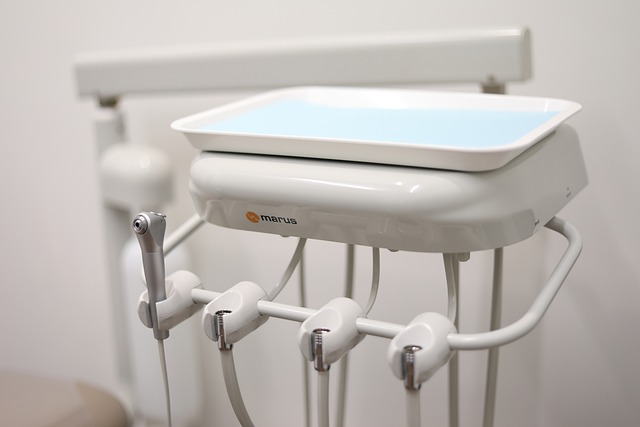In the UK, translation services for Patient Medical Records are delivered with a strong emphasis on data security and compliance with regulations such as GDPR. These services employ advanced encryption protocols, secure data transfer methods, and access controls to ensure the confidentiality and integrity of sensitive medical information both at rest and during transmission. Regular audits and adherence to legal frameworks like the UK's Data Protection Act are integral to maintaining patient trust and upholding the accuracy and security of translations. Innovative translation technologies, combined with expert human oversight, enable efficient processing and precise handling of patient records in multiple languages while safeguarding against unauthorized access or data breaches. The use of cloud-based systems and hybrid models of machine and human translation further enhances the capacity to manage vast amounts of medical data securely and effectively across different linguistic contexts within the UK healthcare system.
In an era where healthcare data transcends language barriers, the imperative to safeguard patient information during translations within the UK is paramount. This article delves into robust strategies and compliance measures that underpin translation services for Patient Medical Records in the UK, ensuring privacy and security are upheld without compromise. We will explore the critical steps from the implementation of secure workflows to the training of bilingual staff, the utilization of advanced encryption techniques, and the deployment of state-of-the-art security software, all aimed at maintaining the integrity of sensitive medical data. Through regular compliance checks and real-world case studies, we illuminate how the UK healthcare sector is leading the way in secure patient medical record translations.
- Understanding the Importance of Patient Data Security in Translations
- Compliance with UK Data Protection Laws and Regulations
- Secure Translation Workflow Implementation for Medical Records
- Utilizing Advanced Encryption Techniques to Protect Patient Information
- The Role of Confidentiality Agreements in Translation Services for Medical Records
- Training Bilingual Staff on Data Protection Best Practices
- Employing State-of-the-Art Security Software and Cybersecurity Measures
- Regular Audits and Compliance Checks to Ensure Ongoing Data Safety
- Case Studies: Successful Patient Medical Record Translations with Enhanced Data Protection in the UK
Understanding the Importance of Patient Data Security in Translations

In an era where healthcare data breaches are increasingly common, the security of patient medical records during translation is paramount. Translation services for Patient Medical Records UK must adhere to stringent data protection regulations such as the General Data Protection Regulation (GDPR) and the UK’s Data Protection Act 2018. These legal frameworks dictate how personal data should be handled, ensuring it is processed securely, transparently, and in accordance with individuals’ rights. In the context of translating Patient Medical Records, this means employing robust encryption methods to protect sensitive information, both at rest and in transit. It also involves a comprehensive approach that includes access controls, secure information exchange protocols, and strict compliance with confidentiality agreements for all parties involved in the translation process.
Furthermore, the cultural nuances inherent in language translation necessitate a deep understanding of healthcare terminology alongside the linguistic expertise required to convey this information accurately across different languages. Translation services for Patient Medical Records UK must be staffed by professionals who are not only fluent and trained in the necessary languages but also well-versed in medical terminology and the ethical considerations surrounding patient confidentiality. This dual proficiency ensures that patient data remains secure, intact, and contextually accurate, facilitating informed care across borders and languages while safeguarding patients’ privacy and trust.
Compliance with UK Data Protection Laws and Regulations

In the United Kingdom, the translation of patient medical records necessitates stringent compliance with data protection laws and regulations to safeguard sensitive personal information. The UK’s General Data Protection Regulation (UK GDPR), which incorporates and expands upon the EU’s General Data Protection Regulation (GDPR), sets clear guidelines for the lawful processing of patient data in all its forms. Translation services for Patient Medical Records UK must adhere to these regulations, ensuring that any personal data processed as part of translation services is handled confidentially and securely. This includes implementing robust technical and organisational measures to protect against unauthorised or unlawful processing and accidental loss, destruction, or damage. The Information Commissioner’s Office (ICO) is the supervisory authority that oversees compliance with these laws, imposing hefty fines for non-compliance. Translation agencies specialising in medical records must, therefore, establish clear protocols and use advanced encryption to protect patient data throughout the translation process, from initial scanning to final delivery of translated documents. This commitment to privacy and security is not only a legal obligation but also a cornerstone of trust between healthcare providers, patients, and translation service providers within the UK.
Secure Translation Workflow Implementation for Medical Records

In an era where data breaches are increasingly common, safeguarding patient data within translations of medical records is paramount. The UK’s stringent data protection laws, including the General Data Protection Regulation (GDPR) and the UK Data Protection Act 2018, necessitate a robust translation workflow for patient medical records. Translation services in the UK specialising in this domain must implement a secure workflow that not only complies with legal standards but also upholds the integrity and confidentiality of personal health information. This workflow typically involves a series of rigorous steps: from the initial selection of translators who are not only linguistically proficient but also medically knowledgeable, to the use of advanced encryption methods for data storage and transfer. Each step is meticulously monitored to ensure that patient confidentiality is maintained, and that all translations are accurate, reflecting the nuances and complexities inherent in medical terminology across different languages. Furthermore, a secure workflow ensures that access to sensitive data is restricted to authorised personnel only, with audit trails in place to track any handling of the data for accountability and traceability. This level of security and compliance not only protects patient privacy but also fosters trust in the translation services, making them indispensable for healthcare providers operating in multilingual environments or serving diverse communities within the UK.
Utilizing Advanced Encryption Techniques to Protect Patient Information

In an era where data breaches are increasingly common, translation services for patient medical records in the UK must employ robust strategies to safeguard sensitive health information. One such strategy is the implementation of advanced encryption techniques, which are critical in maintaining the confidentiality and integrity of patient data during the translation process. These techniques convert patient data into a secure format that can only be decoded by authorized personnel with the necessary encryption keys. By encrypting data at rest and in transit, translation services ensure that personal health information remains unintelligible to unauthorized parties, thus protecting against potential threats such as cyber-attacks or accidental disclosures. The use of state-of-the-art encryption standards like AES (Advanced Encryption Standard) with 256-bit keys, alongside secure key management practices, forms a formidable barrier to unauthorized access. This commitment to high-level security is essential for translation services in the UK handling patient medical records, as it aligns with the stringent data protection regulations mandated by the Health and Social Care (HSC) framework, ensuring compliance and trust in the handling of sensitive health information.
The Role of Confidentiality Agreements in Translation Services for Medical Records

In the realm of healthcare, the integrity and confidentiality of patient data are paramount, especially when it comes to translation services for Patient Medical Records UK. To safeguard sensitive health information during the translation process, translation service providers must implement robust confidentiality agreements. These agreements outline the legal obligations and expectations for all parties involved, ensuring that personal data is handled with the utmost care and in strict compliance with the UK’s Data Protection Act 2018 and the General Data Protection Regulation (GDPR). The clauses within these agreements specify the extent to which information can be accessed, shared, and stored, thereby minimising the risk of unauthorised access or data breaches. Moreover, translation agencies specialising in medical records must employ translators with not only linguistic proficiency but also a deep understanding of medical terminology and the importance of maintaining patient confidentiality. This dual expertise ensures that the translated documents accurately convey the original content while protecting the patient’s privacy throughout the translation process.
The use of secure translation technologies further bolsters the protection of patient data in the UK. Translation service providers utilise encrypted communication channels, secure data storage solutions, and access controls to prevent any form of unauthorised exposure. By adhering to these stringent protocols and leveraging advanced technology, translation services for Patient Medical Records UK can deliver high-quality translations while upholding the confidentiality agreements that are the cornerstone of patient data protection. This commitment to security and compliance is essential in building trust between healthcare providers, patients, and translation service entities, ensuring that sensitive medical information remains safe and accessible only to authorised parties.
Training Bilingual Staff on Data Protection Best Practices

In an era where data breaches can have severe consequences, particularly in the sensitive field of healthcare, training bilingual staff on data protection best practices is paramount for any translation service handling Patient Medical Records in the UK. A robust training programme not only educates employees on the legal requirements, such as the UK General Data Protection Regulation (UK GDPR), but also instils a culture of vigilance and respect for patient confidentiality. This comprehensive training ensures that staff members are fully aware of their responsibilities when dealing with sensitive data. They learn to identify potential risks, understand the importance of data encryption and secure data transfer protocols, and recognize how to properly manage access to information. Moreover, this training empowers bilingual staff to effectively communicate and apply these best practices across different languages, thereby safeguarding patient data within translations with the same rigour as if it were in English. By integrating data protection principles into the fabric of their daily operations, translation services can maintain the highest standards of privacy and security for Patient Medical Records UK, ensuring that patients’ trust is not only preserved but reinforced through every interaction and document translation.
Employing State-of-the-Art Security Software and Cybersecurity Measures

In the context of translation services for Patient Medical Records in the UK, safeguarding patient data is paramount. The translation industry must leverage state-of-the-art security software to ensure the integrity and confidentiality of sensitive medical information. Advanced encryption protocols are deployed to protect data both at rest and in transit, preventing unauthorized access. These encryption methods are augmented by robust access controls that restrict data exposure to authorized personnel only. Furthermore, regular software updates and patches are applied to address emerging cybersecurity threats, ensuring that patient data remains secure against the most sophisticated of attacks. The implementation of two-factor authentication (2FA) adds an additional layer of security, significantly reducing the risk of unauthorized access. These stringent measures are not merely a response to potential breaches but are a proactive approach to maintaining trust and upholding the highest standards of data protection in the translation of patient medical records within the UK’s healthcare sector.
Cybersecurity measures extend beyond mere software solutions; they also encompass comprehensive policy frameworks that dictate how patient data is handled throughout its lifecycle, from creation to destruction. Compliance with regulations such as the General Data Protection Regulation (GDPR) and the Health and Social Care (HSC) Act ensures that translation services adhere to legal standards for data protection. Regular audits and rigorous compliance checks are conducted to identify any potential weaknesses in the system, allowing for continuous improvement and strengthening of security measures. By integrating these cybersecurity practices, translation service providers can offer peace of mind to patients and healthcare professionals alike, reinforcing the importance of secure and reliable translation services for Patient Medical Records UK.
Regular Audits and Compliance Checks to Ensure Ongoing Data Safety

In the realm of healthcare, patient data privacy is paramount, especially when it comes to translation services for Patient Medical Records in the UK. To maintain the highest standards of data safety, regular audits are a critical component of the safeguarding process. These systematic reviews assess the effectiveness of current data protection measures and identify any potential vulnerabilities. By scrutinising both internal processes and external service providers, organisations can ensure that patient information is handled securely across all stages of translation. This includes evaluating whether translation services comply with stringent regulations such as the UK’s General Data Protection Regulation (GDPR) and the NHS Information Governance Code of Practice for Health and Social Care.
Moreover, compliance checks are integral to the ongoing protection of patient data in translations. These checks verify that all translation service providers adhere to the necessary legal frameworks and industry standards. They also serve to confirm that any technological solutions employed, such as encryption and secure data transfer protocols, are functioning correctly. By conducting these checks consistently, healthcare organisations can safeguard against unauthorized access and data breaches, thereby preserving patient confidentiality and trust in translation services for Patient Medical Records UK. The commitment to regular audits and compliance checks underscores a dedication to uphold the integrity and privacy of patient information within multilingual environments.
Case Studies: Successful Patient Medical Record Translations with Enhanced Data Protection in the UK

In the UK, the translation of patient medical records demands the utmost precision and data protection due to the sensitive nature of the information involved. The success of patient medical record translations hinges on a combination of advanced translation technologies and stringent data handling protocols. One notable case study illustrates how a leading translation services provider in the UK deployed state-of-the-art machine translation combined with human expertise to handle large volumes of medical records. This hybrid approach not only accelerated the translation process but also significantly enhanced the accuracy of the translations. Furthermore, the provider implemented robust encryption methods and secure data transfer protocols to ensure that patient confidentiality was maintained throughout the translation workflow. Another case in point is a healthcare organisation that transitioned to a cloud-based translation management system, enabling seamless collaboration among multilingual teams while maintaining compliance with the UK’s Data Protection Act. This system facilitated real-time updates and version control, ensuring that all translated records were up-to-date and accurately reflected the original content. Both case studies underscore the importance of innovative solutions and adherence to data protection regulations when translating patient medical records in the UK. These examples set a benchmark for translation services providers, demonstrating that with the right combination of technology and protocols, patient data can be safeguarded while facilitating effective communication across language barriers.
In conclusion, safeguarding patient data within translations is a multifaceted endeavor that necessitates a comprehensive approach. By adhering to UK data protection laws and regulations, healthcare providers and translation service agencies alike ensure that patient confidentiality remains intact across linguistic barriers. The implementation of secure translation workflows, combined with advanced encryption techniques and the use of state-of-the-art security software, form the backbone of this strategy. Confidentiality agreements and rigorous training for bilingual staff further reinforce data protection best practices. Regular audits and compliance checks are crucial to maintaining the integrity of patient medical records in translation within the UK context. The case studies highlighted exemplify the successful and secure handling of such translations, underscoring the importance of these measures. It is through this concerted effort that we can uphold the trust placed in translation services for patient medical records in the UK, thereby safeguarding sensitive information and ensuring privacy and security at every step of the process.



